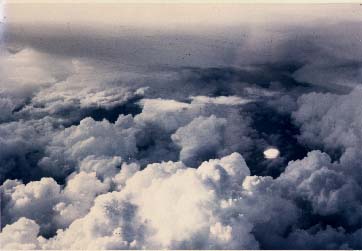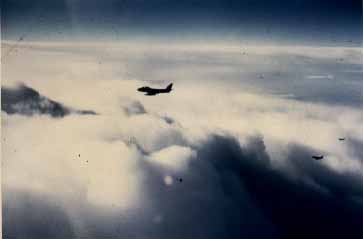Classification: MA-1 n1The classification scheme (e.g. MA-1) was presented in a previous paper by Vallee.


The witnesses in this MA-1 case are Royal Canadian Air Force pilots who were flying in a formation of four F-86 Sabre
jet aircraft (Figure 1). The planes were flying at
36000 pieds
, headed due west over the Canadian Rockies, about an hour before sunset s3R. J. Childerhose: Affidavit written in May 1958, and private communication to Dr. B. Maccabee.
. As they were approaching a large thunderhead R. J. Childerhose, the pilot in the second position (left side of the
formation) saw a bright light which was sharply defined and disc-shaped
or like a shiny silver dollar
sitting horizontal,
far below the planes but above the lower layer of clouds. It appeared to be considerably
brighter than the sunlight.
(Figure 2.)
Sighting duration was variously quoted at (Klass, 1968) to . The pilot reported the observation to the flight leader, then took a photograph of it. That photograph, a Kodachrome color slide, was subsequently analyzed by Dr. Bruce Maccabee who considered the hypotheses that the object was a cloud, a plasma phenomenon, or ball lightning (kugelblitz). We refer the reader to his detailed study s4Maccabee, Bruce. "Optical Power Output of an Unidentified High Altitude Light Source." Private communication. while presenting here only a summary of his arguments.
The cloud hypothesis was contradicted by two facts, namely the equal brightness of the object on both sides as opposed to the darker appearance of clouds away from the sunlight, and the fact that portions of the object were brighter than the brightest clouds.
The plasma or ball lightning hypothesis has been mentioned by Klass (Klass, 1968) and by Altschuler (Altschuler, 1968). It is contradicted by the radiance of the object and the duration of the observation. Maccabee derives the radiance L by solving the standard photographic equation, corrected for the effects of atmospheric attenuation:
L=4Ef2exp[(b-a)/cosθ]/Tcos4Φ (1)
where
E=H/t. (2)
H is the film exposure level in J/cm2 and t is the shutter time in seconds. L is the radiance of the object in the direction of the camera in W/sr/cm2, E is the irradiance on the focal plane of the camera in W/cm2, and f is the ratio of the focal length to the diameter, as set by the operator of the camera. The factor exp[(b-a)/cosθ] corrects for atmospheric attenuation, b being the optical thickness of the atmosphere from the ground to the altitude of the plane, a the optical thickness to the altitude of the object and θ the zenith angle of the slant path from the plane to the object. T is the transmission of the optics (aircraft window and lens) and f is the angle between the optic axis of the camera and the optical path from the lens to the image.
We refer the reader to Maccabee’ s analysis for an excellent discussion of the range of values of these parameters. He finds a value between 1.09 and 1.34 for the attenuation correction factor, a value of 0.7 for T, shutter time of 1/125 at f/8 and a value of 0.95 for cos4Φ. The average density over much of the image is estimated at 0.12, leading to a value of H = 10-4 J/cm2.
Inserting these values into (eq. 1) and (eq. 2) gives estimates of radiance of 1.7 to 2.0 W/sr/cm2 if the object was at distances of 6 or 20 kilometers, respectively. Assuming that the object was a Lambertian emitter with constant emittance over its surface, Maccabee finds a range of 2.5 × 109 W (2,500 megawatts) to 3 × 1010 W (30,000 megawatts) for the power output within the spectral range of the film. As he rightly points out, however, a the total power emitted over all frequencies might be much greater.o